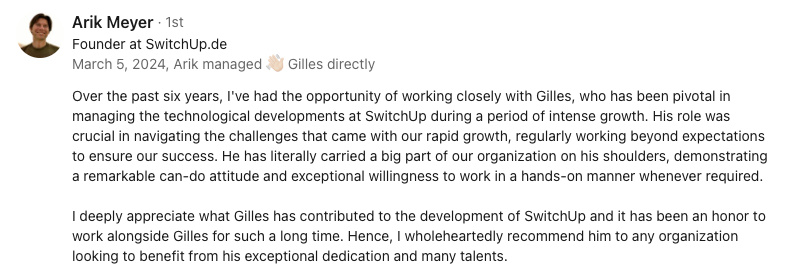Abstract:
The article argues that while digital MVPs (Minimum Viable Products) may attract impressive metrics like clicks and sign-ups, these signals often reflect curiosity rather than true user commitment, leading to misguided confidence and missed real-world challenges. It advocates for tech professionals to supplement or replace digital tests with offline MVPs—simple, hands-on experiments like paper prototypes in cafés, manual demos at meetups, or pop-up events—which reveal genuine user needs, logistical issues, and opportunities for meaningful feedback that online analytics often overlook. Drawing on examples from companies like Airbnb, Zappos, Instacart, Dropbox, and ClassPass, as well as guidance from thought leaders such as Eric Ries, Steve Blank, and Rob Fitzpatrick, the article emphasizes that offline MVPs foster deeper learning, build valuable soft skills, and help avoid the trap of “vanity metrics.” It offers practical strategies for conducting these experiments with minimal risk, including staying compliant with employment agreements, using personal resources, and focusing on observable user behavior rather than theoretical interest. The piece also highlights the rejuvenating effect of real-world experimentation for tech workers experiencing digital burnout, describing how even small-scale, face-to-face trials can uncover crucial insights and build authentic connections. By blending offline feedback with digital data and following clear decision rules, creators can determine whether to proceed, pivot, or quit, ultimately learning quickly and efficiently while gaining both product clarity and human connection—sometimes sparked by nothing more than a conversation over coffee.
When digital MVPs rack up clicks and sign-ups, it’s tempting to think you’re onto something. But, as I learned the hard way in Berlin, those shiny numbers don’t always mean real demand. Curiosity is not commitment. You only find out what matters when people step away from their screens and actually interact with your idea in real life.
I want to share why offline MVPs are often the missing piece for tech workers—especially those of us in Europe, where employment contracts and work culture can make side projects tricky. Offline experiments reveal hands-on challenges and user needs that digital signals just don’t catch. From the problem with vanity metrics to simple ways of trying out ideas outside the internet, I’ll walk you through practical approaches that bring a product closer to what people actually want.
You’ll find my own stories, useful strategies, and a bit of humor—plus the occasional typo or French-tinged syntax (sometimes, I forget a word in English, but you get the idea, non?). Whether you’re testing a paper prototype in a Lisbon café or doing a manual demo at a Berlin meetup, taking things offline can lead to better ideas, stronger products, and maybe even a real connection. Let’s see what happens when you bring your next big idea out from behind the screen.
Why real-world MVPs matter
The limits of digital validation
It’s easy to feel good when a landing page racks up hundreds of clicks, or the waitlist grows fast. Digital MVPs, so common in the startup playbook, might look like proof of demand. But these digital efforts often only show curiosity. I remember my first side project test in Berlin: I got 120 sign-ups online, but when I invited people to try the service in person, only three showed up. That was a wake-up call.
A click or a signup is not the same as a sale, and rarely shows true commitment. Digital signals alone can trick us into thinking we’re making real progress, leaving us stuck on “vanity metrics” instead of real traction. Harvard Business School explains this trap well.
This confusion can slow down the discovery of problems. For example, a food delivery service might attract lots of signups with a website, but not reveal if onboarding is confusing or if actual deliveries are delayed because of logistics. Instacart and DoorDash both noticed serious challenges only when real people tried using the service in real life. Digital MVPs miss these everyday problems that only show up offline.
When I ran a concierge MVP for a SaaS tool in Berlin, only 2 out of 15 testers returned for a second session. That told me more than any online survey. Here’s what I learned:
- Online interest is cheap; showing up in person is rare.
- Most feedback happens between the lines—watching people struggle or smile tells you more than a form ever will.
- If only a handful return, it’s time to rethink the idea or the execution.
Superhuman found key workflow gaps only after talking directly to users. Teams can spend months making a product look perfect, then find out too late that users need something completely different. It’s like building a beautiful ship, then learning no one wants to sail it.
The power of offline experiments
Offline MVPs ask users to take real action. Maybe it’s a paper prototype in a local café or a pop-up event on a Saturday; people have to show up, use the idea, and take part. Someone who joins in person is showing true curiosity, not just clicking a button. There’s something more direct about these moments.
During my time in Lisbon, I ran a paper prototype test at a local café. The feedback was far more insightful than anything I gathered online—one person even pointed out a step that made no sense, which I’d never noticed before. In Berlin, local coworking spaces offered the perfect setting for discreet offline MVP tests, especially given the strict employment contract norms here.
Face-to-face feedback gives you nonverbal cues—confusion, excitement, or hesitation—that analytics miss. Watching someone frown at a paper mockup or glow with interest can tell you more than many surveys. Also, running these experiments teaches more than product details. IDEO and the Nielsen Norman Group note that in-person feedback can reveal subtle reactions and needs, giving a richer sense of what matters.
Doing real-world experiments also helps build soft skills and networks—very useful for the long run. It is not only about testing an idea, but learning to listen, adapt, and connect with people. And yes, sometimes it’s awkward, and you drink too much coffee, but that’s part of the fun.
Simple offline MVPs
Easy offline MVPs for busy tech workers
For tech professionals short on time and resources, offline MVPs don’t have to be complicated. One way is to manually test a service at a local meetup or coworking spot. A “concierge” pilot means delivering the service yourself to a few people, listening to their feedback, and learning immediately. Steve Blank suggests this for uncovering true needs and real-life hiccups, without any code. For something even simpler, paper or physical mockups work well.
Back in Guignes, I once tested a gardening app idea by handing out paper mockups at the local market. The feedback was blunt, but it saved me weeks of coding. Only one person said they’d actually use it, and that was my neighbor’s cousin.
Key lessons from these offline tests:
- Honest feedback comes fast—and sometimes it stings.
- If no one is interested after a real-world test, it’s better to know early.
- You don’t need fancy gear; a pen and paper is enough.
Paper prototypes are a classic, low-cost way to test fast. Take sketches or printouts to a coffee shop, let people try a scenario, and gather honest feedback. Eric Ries and Tom Kelley both recommend this as a way to see what confuses people before you write a single line of code.
Pop-up events or workshops—like a one-day bootcamp or a “manual” subscription test—can show if people are willing to pay and help spot logistics issues early. Some ways to do this:
- Host a pop-up class or mini-workshop in a community spot
- Set up a sign-up table for pre-orders at a fair
- Offer a trial version of your service, doing all the work by hand, for a small group
Companies like ClassPass and Airbnb did things like this in the early days. These tests show both demand and how well delivery actually works. Of course, always stay on the right side of the rules.
Staying compliant
If you’re thinking about a side project, especially in Europe, check your employment contract for invention assignment, non-compete, and confidentiality rules. Many tech companies want rights over anything connected to their work or resources. Harvard Business Review and Stanford OTL both recommend checking these points, and if you’re unsure, getting legal help. Once you know where things stand, use only your own resources to avoid issues.
Here are a few ways to keep things clear:
- Use your own devices, accounts, and money for your side project
- Never use work time, office computers, or company accounts for your project
Keeping good records also helps. You might:
- Do all tests and work sessions outside of your job time
- Keep time logs and notes showing the project is your own
Running these experiments on weekends or after work helped me avoid conflicts with my main job and kept my side projects sustainable. Being careful like this protects you and shows you’re acting fairly. Once these basics are set, you’re ready to start collecting and using feedback from offline MVPs.
Gathering real feedback
Honest feedback in person
When gathering feedback in person, focus on real behavior, not theory. Instead of, “Would you use this app?” try, “Tell me about the last time this was a problem for you.” This idea from Rob Fitzpatrick’s The Mom Test and the Jobs To Be Done framework helps get at what really matters.
Avoid leading questions and fishing for approval. Let users interact with your test or service as naturally as possible and watch for pauses, confusion, or surprise. Sometimes a puzzled face tells you more than a dozen polite comments, just as IDEO’s design approach or Google Ventures’ Five-Act Interview suggests.
Notice both what people say and what they do. Feedback lives in the raised eyebrow, a frown, or even when someone reaches for their wallet—or decides to wander away. This was noted by the Nielsen Norman Group and in research by Dholakia & Simonson. Picking up these cues gives you a deeper view than words alone.
When I ran a manual demo at a Lisbon coworking space, I noticed that people hesitated at the payment step. Only one person actually paid, but their excitement was real—and that was enough to keep me going for another round of tests.
Making sense of offline signals
Real demand shows up through what people do. To avoid bias, stay organized and look for clear signals—things like sign-ups, pre-orders, or honest pushback—rather than just kind encouragement. It can help to ask: Did anyone try to pay? Did someone return for more? Did they challenge your idea? These signs matter most.
Keep all your feedback in one place. Whether it’s a notebook or a spreadsheet, having each session recorded helps spot patterns and stops you from overreacting to a single comment. Worksheets from Y Combinator, Techstars, or Lean Canvas can help keep this process simple.
After each experiment, I ask myself:
- What worked?
- What was surprising?
- What needs another test?
Changing your approach is normal—even negative feedback early on can save you a lot of work later. Offline MVPs are practical and fit the minimalist, people-focused approach.
Minimalist, human-first MVPs
The human-first approach
After years of working in fast-paced tech environments, I realized that testing ideas offline not only gave me better feedback but also helped me reconnect with people and avoid digital burnout. Many in tech look for projects that offer real world connection and visible results—something you can touch or see, not another graph on a dashboard. Simple experiments like running a workshop or sketching with a pen and paper are a good break from digital overload.
Reports from the Microsoft Work Trend Index and Wired UK show digital burnout is real, with people searching for more hands-on, people-focused work, as more get interested in the so-called analog startup style.
Offline MVPs don’t need fancy gear or big spending. You could test an idea with just a whiteboard and a few friends, or set out a sign-up sheet at a local event. Formats like the concierge MVP used by Stripe and in-person pilots by ClassPass prove it’s possible to test an idea without big money or risk.
Human-first MVPs teach you things you can’t get from coding. Listening, improvising, and quickly adjusting are skills that stick with you. Research from ACM Interactions and tips from Paul Graham highlight how empathy and working with users can shape not only your product but also your future work.
Living in different cities—Beijing, Berlin, Lisbon—has shaped my approach. In Beijing, I learned to adapt quickly when language or culture made feedback less direct. In Berlin, people are blunt (sometimes too much!), but you always know where you stand. Lisbon taught me to slow down and listen more.
Snapshots from the field
Picture a developer (okay, me) trying out a SaaS workflow at a local startup hub in Berlin. By walking users through each step by hand, I found trouble spots that digital surveys would miss. Dropbox and Slack did in-person tests early on, finding issues and usability gaps that later shaped design. These MVPs also show what customers care about most.
At a community event, I offered a manual subscription service. Instead of focusing on features, I learned that easy sign-up and flexibility matter most—a surprise that changed my product’s course. This kind of face-to-face discovery also happened with ClassPass and Intuit’s “Follow Me Home” sessions, leading to smarter priorities and shift in direction.
Sometimes, hands-on trials highlight hardware or onboarding issues, too. For example, a team runs a pop-up repair clinic and soon sees real hardware problems and tough onboarding steps—things no online survey could catch. Research for Swiffer at P&G and stories on Indie Hackers both show how physical testing helps catch big problems before they get expensive.
I remember feeling anxious when only one person showed up to my first offline test in Berlin, but that honest feedback changed my whole approach. And seeing someone smile and reach for their wallet after trying my prototype was a small victory that kept me going.
Turning offline data into decisions
Blending offline and online signals
Mixing offline and online feedback isn’t so hard. Offline trials give you direct and honest reactions—surprised looks or moments of silence. Digital stats, in contrast, present patterns and numbers at a bigger scale. When you combine these, you get a fuller picture, less tilted by any one type of data.
The tools can be simple. Write down what you notice in a notebook, and later keep digital stats, like sign-ups or retention, in a spreadsheet or a dashboard. Using MVP worksheets from Y Combinator or Techstars, or an AARRR tracker, can be plenty for most side projects.
After each round, I take a moment for a short review. I ask what I learned, what surprised me, and if there is genuine traction or just polite interest. These questions—like in Lean Canvas retrospectives—help spot true signals and avoid getting optimistic for no reason. With all your data, the next choice is whether to keep going, make a change, or call it a day.
Proceed, pivot, or quit?
Deciding what to do next is easier with clear rules set before you start. You might say, “If five people pay, keep going”; “If users keep missing a step, change something”; or “If nobody shows up three times, move on.” These guidelines, based on Steve Blank’s Customer Development and Lean Startup, help you decide with your head, not just your heart.
When feedback is mixed, small changes make sense. Try a new pitch, test in a new place, or focus on a different user group. Offline MVPs make switching gears easy—no big code rewrite needed. Tools from Techstars or Lean Startup Machine can help map these pivots.
And sometimes, learning that an idea won’t work is good—that way, you avoid wasting effort. Seeing negative results as data, not as personal failure, is valuable. For those who care about data-driven choices, combining real-world feedback with simple metrics makes it much easier to stay neutral—even when you’re excited about an idea. Sometimes, the best result is freeing up time and energy for something new, and enjoying a fresh coffee while you think about what's next.
Testing ideas offline may seem old-fashioned in a world full of dashboards and clicks, but it brings clarity and honesty you just can't get anywhere else. Real-world MVPs show you true demand, real-life problems, and unexpected moments that shape better products. Even small experiments—like a paper prototype at a café or a hands-on test at a local meetup—can bring feedback you’d never spot in analytics. With a few simple steps to stay legal and low-risk, anyone can try these approaches and learn quickly. It’s about more than testing an idea. It’s also a way to make real connections and learn practical skills you can use again and again. Sometimes, the best ideas don’t come from the code—they start with a real conversation over coffee.














